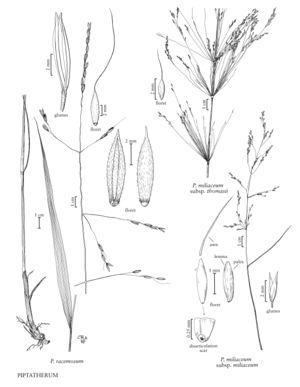familyPoaceae
subfamilyPoaceae subfam. Pooideae
genusPiptatherum
speciesPiptatherum miliaceum
subspeciesPiptatherum miliaceum subsp. thomasii
Difference between revisions of "Piptatherum miliaceum subsp. thomasii"
Treatment appears in FNA Volume 24.
FNA>Volume Importer |
FNA>Volume Importer |
||
| Line 15: | Line 15: | ||
-->{{Treatment/Body | -->{{Treatment/Body | ||
| − | |discussion=<p>Piptatherum miliaceum subsp. thomasii has a native range similar to that of subsp. miliaceum, except that it does not grow in semidesert regions. In the Flora region, it is known only from cultivated specimens.</p> | + | |discussion=<p><i>Piptatherum miliaceum </i>subsp.<i> thomasii</i> has a native range similar to that of <i></i>subsp.<i> miliaceum</i>, except that it does not grow in semidesert regions. In the Flora region, it is known only from cultivated specimens.</p> |
|tables= | |tables= | ||
|references= | |references= | ||
| Line 24: | Line 24: | ||
-->{{#Taxon: | -->{{#Taxon: | ||
name=Piptatherum miliaceum subsp. thomasii | name=Piptatherum miliaceum subsp. thomasii | ||
| − | |||
|authority=(Duby) Sojak | |authority=(Duby) Sojak | ||
|rank=subspecies | |rank=subspecies | ||
| Line 31: | Line 30: | ||
|basionyms= | |basionyms= | ||
|family=Poaceae | |family=Poaceae | ||
| − | |illustrator=Cindy Roché | + | |illustrator=Cindy Roché;Hana Pazdírková |
| + | |illustration copyright=Utah State University | ||
|reference=None | |reference=None | ||
|publication title= | |publication title= | ||
|publication year= | |publication year= | ||
|special status= | |special status= | ||
| − | |source xml=https:// | + | |source xml=https://jpend@bitbucket.org/aafc-mbb/fna-data-curation.git/src/f50eec43f223ca0e34566be0b046453a0960e173/coarse_grained_fna_xml/V24/V24_204.xml |
|subfamily=Poaceae subfam. Pooideae | |subfamily=Poaceae subfam. Pooideae | ||
|tribe=Poaceae tribe Stipeae | |tribe=Poaceae tribe Stipeae | ||
Revision as of 21:19, 16 December 2019
Branches densely whorled; lower nodes with 15-30+ branches, some sterile, bearing highly reduced or no spikelets.
Discussion
Piptatherum miliaceum subsp. thomasii has a native range similar to that of subsp. miliaceum, except that it does not grow in semidesert regions. In the Flora region, it is known only from cultivated specimens.
Selected References
None.
Lower Taxa
None.
